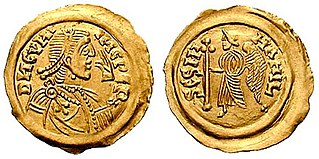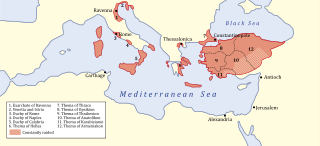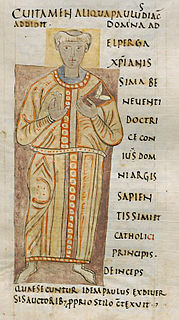Related Research Articles
Pope Gregory II was the bishop of Rome from 19 May 715 to his death. His defiance of Emperor Leo III the Isaurian as a result of the iconoclastic controversy in the Eastern Empire prepared the way for a long series of revolts, schisms and civil wars that eventually led to the establishment of the temporal power of the popes.
Pope Gregory III was the bishop of Rome from 11 February 731 to his death. His pontificate, like that of his predecessor, was disturbed by Byzantine iconoclasm and the advance of the Lombards, in which he invoked the intervention of Charles Martel, although ultimately in vain. He was the last pope to seek the consent of the Byzantine exarch of Ravenna for his election, and the last non-European Pope until the election of Pope Francis on March 13, 2013.
The 740s decade ran from January 1, 740, to December 31, 749.

Year 740 (DCCXL) was a leap year starting on Friday of the Julian calendar, the 740th year of the Common Era (CE) and Anno Domini (AD) designations, the 740th year of the 1st millennium, the 40th year of the 8th century, and the 1st year of the 740s decade. The denomination 740 for this year has been used since the early medieval period, when the Anno Domini calendar era became the prevalent method in Europe for naming years.

Year 776 (DCCLXXVI) was a leap year starting on Monday of the Julian calendar. The denomination 776 for this year has been used since the early medieval period, when the Anno Domini calendar era became the prevalent method in Europe for naming years.

The Duchy of Spoleto was a Lombard territory founded about 570 in central Italy by the Lombard dux Faroald. Its capital was the city of Spoleto.

The Duchy of Benevento was the southernmost Lombard duchy in the Italian Peninsula that was centred on Benevento, a city in Southern Italy. Lombard dukes ruled Benevento from 571 to 1077, when it was conquered by the Normans for four years before it was given to the Pope. Being cut off from the rest of the Lombard possessions by the papal Duchy of Rome, Benevento was practically independent from the start. Only during the reigns of Grimoald, King of the Lombards and the kings from Liutprand on was the duchy closely tied to the kingdom. After the fall of the kingdom, however, it was the sole Lombard territory to continue to exist as a rump state, maintaining its de facto independence for nearly 300 years, although it was divided after 849.

Liutprand was the king of the Lombards from 712 to 744 and is chiefly remembered for his multiple phases of law-giving, in fifteen separate sessions from 713 to 735 inclusive, and his long reign, which brought him into a series of conflicts, mostly successful, with most of Italy. He is often regarded as the most successful Lombard monarch, notable for the Donation of Sutri in 728, which was the first accolade of sovereign territory to the Papacy.

The Battle of Coronate took place in 689, after King Cunicpert returned from exile and ousted Alahis, Usurper King and Duke of Trent, from the capital Pavia.

The Donation of Sutri was an agreement reached at Sutri by Liutprand, King of the Lombards and Pope Gregory II in 728. At Sutri, the two reached an agreement by which the city and some hill towns in Latium were given to the Papacy, "as a gift to the blessed Apostles Peter and Paul" according to the Liber Pontificalis. The pact formed the first extension of papal territory beyond the confines of the Duchy of Rome and was the first of two land transfers from Liutprand to the Church of Rome.

Gisulf II was the third last duke of Benevento before the fall of the Lombard kingdom. He ruled from 743, when King Liutprand came down and removed Godescalc, to his death up to ten years later.
Hilderic was the Lombard Duke of Spoleto briefly from 739 to 740. He was the first appointee of Liutprand, King of the Lombards, against the rebellious Thrasimund II.

The Duchy of Rome was a state within the Byzantine Exarchate of Ravenna. Like other Byzantine states in Italy, it was ruled by an imperial functionary with the title dux. The duchy often came into conflict with the Papacy over supremacy within Rome. The duchy was founded by the conquest of Emperor Justinian I in 533 AD. After the founding of the Papal States in 751, the title of Duke of Rome fell into disuse.
Thrasimund I or Transamund I was the Count of Capua and then Duke of Spoleto, a faithful follower of Grimoald I of Benevento.
Faroald II was the duke of Spoleto from 703, when he succeeded his own father Thrasimund I.
Agiprand was briefly the Duke of Spoleto between 742 and 744.
Ago was the Duke of Friuli from between 651 and 661 until about 663. He succeeded Grasulf II.
Lupus was the Duke of Friuli from between 660 and 663 to his death around 666.
Hildeprand was the Duke of Spoleto from 774 to 789.

Adelperga was a Lombard noblewoman, Duchess of Benevento by marriage to Arechis II of Benevento. She acted as regent of Benevento for her son Grimoald in 787-788. She was the third of four daughters of Desiderius, King of the Lombards, and his wife Ansa. Her elder sister Desiderata was a wife of Charlemagne.
References
- ↑ Lars Ulwencreutz (November 2013). Ulwencreutz's The Royal Families in Europe V. Lulu.com. p. 350. ISBN 978-1-304-58135-8.
- ↑ Hartmann, Ludo Moritz. Geschichte Italiens im Mittelalter. II, 2, 137–138.
- ↑ Hodgkin, Thomas. Italy and her Invaders. Clarendon Press, 1895. pp 475–478.
- ↑ Hartmann, II, 2, 139.
- ↑ Hartmann, II, 2, pp. 139, 140.